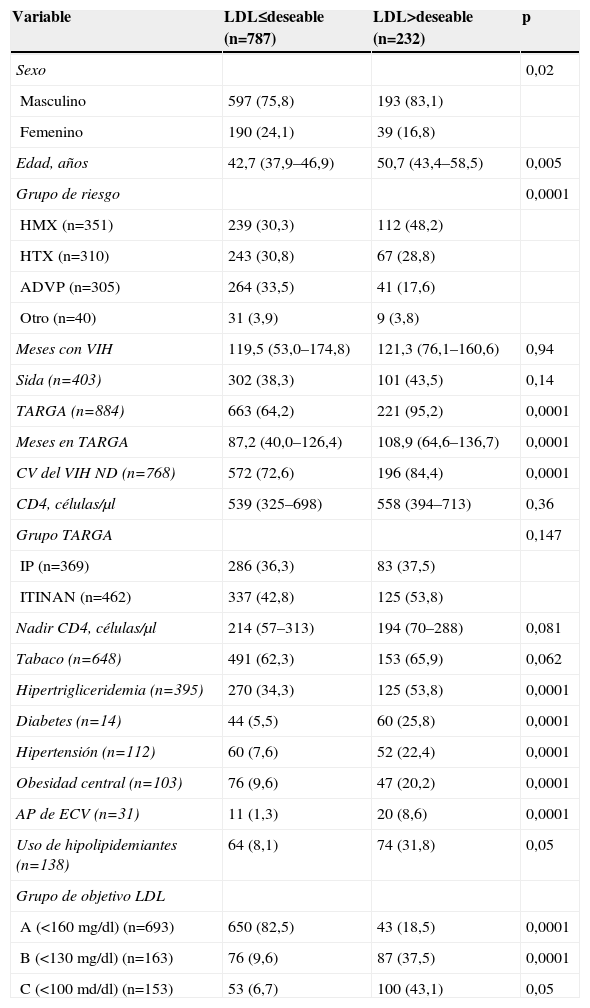Conocer la prevalencia de pacientes con infección por el virus de la inmunodeficiencia humana que no cumplen los objetivos de colesterol ligado a lipoproteínas de baja densidad (cLDL).
Pacientes y métodoEstudio multicéntrico transversal de todos los pacientes con virus de la inmunodeficiencia humana que acudieron a revisión en 5 hospitales de la provincia de Málaga entre marzo y agosto de 2007. Se clasificaron en función de su cLDL deseable National Cholesterol Education Program (NCEP): grupo A inferior a 160mg/dl (pacientes sin factor de riesgo cardiovascular [FRCV] o solo un FRCV); grupo B inferior a 130mg/dl (pacientes con 2 o más FRCV), y grupo C inferior a 100mg/dl (pacientes con enfermedad cardiovascular o equivalentes o con un riesgo cardiovascular [RCV] a 10 años superior al 20%). Se contrastaron los pacientes con cLDL deseable con los que no lo alcanzaban. Programa estadístico: SPSS.
ResultadosSe analizó a 1.019 pacientes, de los que 232 (22,8%) tenían un nivel de cLDL no deseable. En el grupo A había 693 pacientes, en el grupo B 163 pacientes y en el grupo C 153 pacientes; no alcanzaban el cLDL deseable el 6,6, el 53,3 y el 65,0%, respectivamente (p<0,05). Los únicos factores asociados a un cLDL no deseable fueron la obesidad (OR=1,98; IC 95%: 1,14–3,46; p=0,01), el tiempo de tratamiento antirretroviral (por cada 2 años, OR=1,92; IC 95%: 1,85–1,99; p=0,02) y estar incluido en los grupos B y C (OR=16,9; IC 95%: 10,8–26,6; p=0,00001).
ConclusionesEn más de un 20% de los pacientes de nuestra cohorte el cLDL no alcanza los niveles deseables. Los factores asociados a un cLDL no deseable fueron la obesidad abdominal, el tiempo de tratamiento antirretroviral y el estar en los grupos B y C.
To analyse the prevalence of HIV-infected patients who do not reach their target LDL-cholesterol (LDL-C) levels.
Patients and methodsMulticenter, cross-sectional study of all HIV-infected patients on regular follow-up in 5 hospitals in the province of Malaga (March-August/07). They were classified depending on their target LDL-C levels (NCEP): group A:<160mg/dl, if ≤1 cardiovascular risk factor (CVRF); group B: <130mg/dl, if ≥2 CVRF; group C: <100mg/dl, if cardiovascular disease or equivalents or CVR at 10 years >20%). A comparison between patients reaching their target LDL-C levels and those not reaching them was done. Statistic program: SPSS.
ResultsOf 1019 included patients, 232 (22.8%) did not reach their target LDL-C levels. There were 693 patients in Group A, 163 in Group B, and 153 in Group C (6.6%, 53.3 % and 65.0% respectively (p<0.05)) who did not reach their target LDL-C. Factors associated with LDL-C levels higher than target were: obesity (OR=1.98; 95%CI: 1.14–3.46; p=0.01), time on antiretroviral therapy (for each 2 years OR=1.92; 95%CI: 1.85–1.99; p=0.02), and being included in Groups B and C (OR=16.9; 95%CI: 10.8–26.6; p=0.00001).
ConclusionsMore than 20% of the patients in this cohort did not reach their target LDL-C levels. Factors associated with high LDL-C levels were central obesity, time on antiretroviral therapy and being included in Groups B and C.
Artículo
Comprando el artículo el PDF del mismo podrá ser descargado
Precio 19,34 €
Comprar ahora







